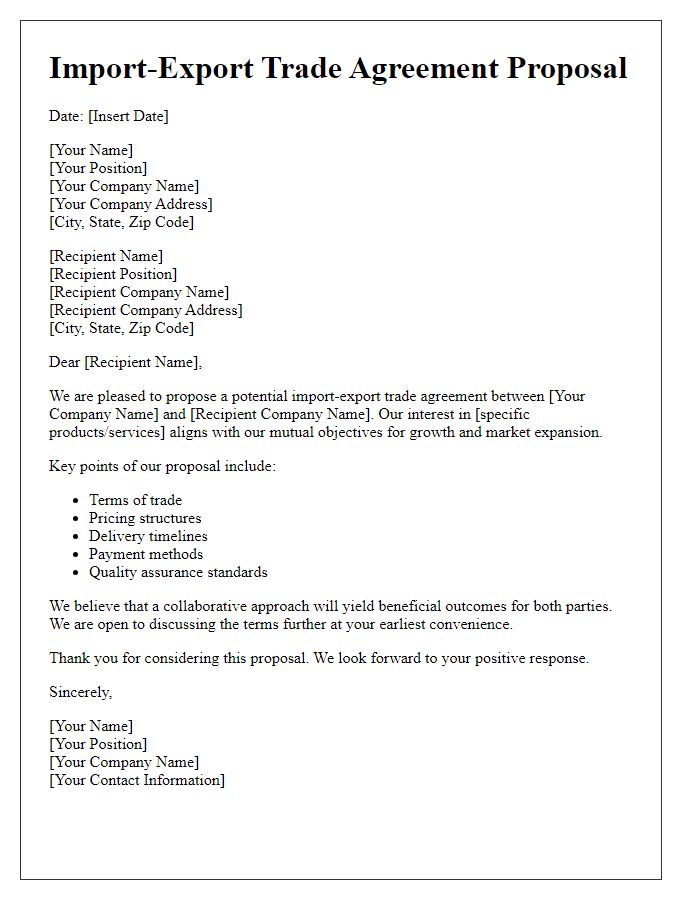Are you looking to expand your import-export business but not sure where to start? A well-crafted letter proposal can be your ticket to building valuable partnerships and securing lucrative deals. In this article, we'll explore effective strategies for drafting an engaging proposal that captures attention while outlining the unique benefits of your business. Ready to elevate your proposal game? Let's dive in!

Business Introduction
A robust import-export business proposal must establish a clear and engaging business introduction. The proposal should highlight the company's expertise in international trade, emphasizing years of operational experience, specialized industry knowledge, and a strong network of global suppliers and customers. It should indicate specific commodities or products the business plans to focus on, such as electronics, textiles, or agricultural goods. References to compliance with trade regulations and logistics capabilities, such as partnerships with freight forwarders and customs brokers, enhance credibility. Additionally, noting the business's commitment to sustainability practices and ethical sourcing can appeal to conscientious partners. This introduction shapes a compelling narrative for stakeholders by showcasing capabilities and aligning with market demands.
Product/Service Details
The import-export business proposal outlines essential product details and services tailored for international trade. Key components include product descriptions, such as specifications (dimensions, weight), materials used, and quality certifications (ISO, CE) relevant to markets like the European Union or North America. Pricing strategies, including unit costs and shipping terms (FOB, CIF), help clarify financial expectations. Logistics services, including customs clearance and transport solutions (air freight, ocean shipping), ensure smooth cross-border operations. Understanding target markets, such as consumer preferences in Asia or supply chain demands in Africa, is critical for successful engagement. Establishing partnerships with local distributors enhances market penetration and provides critical insights into regional regulations and cultural nuances.
Market Analysis
The global import-export industry presents vast opportunities for growth, especially within key markets like Asia, Europe, and North America. In 2021, the global trade value reached approximately $28 trillion, with China being the leading exporter, accounting for about 14% of total world exports. Particularly, the food and beverage sector has shown a steady increase, with a growth rate of 4.3% in the last five years. Emerging markets, such as India and Vietnam, are projected to experience significant demand for imported goods, driven by a growing middle class and increasing disposable incomes. Additionally, advanced logistics hubs, such as Singapore's Changi Airport and Rotterdam's port, facilitate efficient supply chain management, making these regions strategic points for import-export operations. Awareness of local regulations and tariffs is crucial, as countries within the European Union, for instance, have unique compliance requirements that can impact market entry strategies. Furthermore, shifts in consumer preferences toward sustainable and organic products are reshaping the demand landscape, prompting import-export businesses to adapt their product offerings accordingly.
Competitive Advantage
A comprehensive import-export business proposal should highlight the competitive advantage that distinguishes a company in the global marketplace. Key factors include strategic sourcing from countries with lower production costs, utilization of advanced logistics systems to ensure timely delivery, and compliance with rigorous international trade regulations for smooth customs clearance. Understanding and leveraging specific market trends--such as increasing demand for sustainable products--can also provide an upper hand. Networking at international trade shows, like the Canton Fair in China or the Atlanta International Gift & Home Furnishings Market, can enhance visibility and establish critical partnerships. Furthermore, technology can play a pivotal role; implementing data analytics tools to forecast market needs ensures a proactive approach to inventory management, ultimately leading to increased customer satisfaction and loyalty.
Pricing and Terms
Creating a comprehensive pricing and terms outline is crucial for an import-export business proposal. Elements defining pricing may include cost per unit, minimum order quantities (MOQ), shipping fees, and insurance costs. Payment terms generally specify accepted methods such as bank transfers, letters of credit, or PayPal, along with the timeline for payments, like 30 days after invoice receipt. Additional considerations encompass discounts for bulk orders or early payments and penalties for late payments. Clearly stated terms regarding returns, replacements, and warranty policies ensure mutual understanding and establish trust between parties. This section should emphasize transparency and clarity, guiding partners toward successful transactions and ongoing collaboration.













Comments